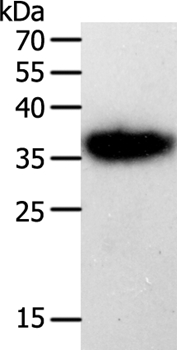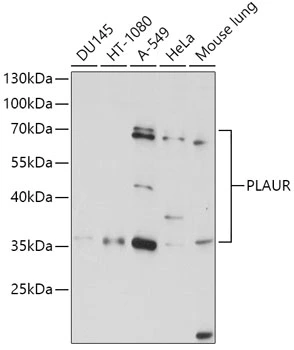uPAR antibody [VIM5] (PE)
GTX00512-08
ApplicationsFlow Cytometry
Product group Antibodies
ReactivityHuman
TargetPLAUR
Overview
- SupplierGeneTex
- Product NameuPAR antibody [VIM5] (PE)
- Delivery Days Customer9
- Application Supplier NoteFACS: 10 microl reagent / 100 microl of whole blood or 106 cells in a suspension. *Optimal dilutions/concentrations should be determined by the researcher.Not tested in other applications.
- ApplicationsFlow Cytometry
- CertificationResearch Use Only
- ClonalityMonoclonal
- Clone IDVIM5
- ConjugateRPE
- Gene ID5329
- Target namePLAUR
- Target descriptionplasminogen activator, urokinase receptor
- Target synonymsCD87, U-PAR, UPAR, URKR, urokinase plasminogen activator surface receptor, monocyte activation antigen Mo3, u-plasminogen activator receptor form 2, urokinase-type plasminogen activator (uPA) receptor
- HostMouse
- IsotypeIgG1
- Protein IDQ03405
- Protein NameUrokinase plasminogen activator surface receptor
- Scientific DescriptionThis gene encodes the receptor for urokinase plasminogen activator and, given its role in localizing and promoting plasmin formation, likely influences many normal and pathological processes related to cell-surface plasminogen activation and localized degradation of the extracellular matrix. It binds both the proprotein and mature forms of urokinase plasminogen activator and permits the activation of the receptor-bound pro-enzyme by plasmin. The protein lacks transmembrane or cytoplasmic domains and may be anchored to the plasma membrane by a glycosyl-phosphatidylinositol (GPI) moiety following cleavage of the nascent polypeptide near its carboxy-terminus. However, a soluble protein is also produced in some cell types. Alternative splicing results in multiple transcript variants encoding different isoforms. The proprotein experiences several post-translational cleavage reactions that have not yet been fully defined. [provided by RefSeq, Jul 2008]
- ReactivityHuman
- Storage Instruction2°C to 8°C
- UNSPSC12352203



![FACS analysis of human peripheral blood using GTX00512 uPAR antibody [VIM5].](https://www.genetex.com/upload/website/prouct_img/normal/GTX00512/GTX00512_20191025_AP_006_49_w_23053121_721.webp)
